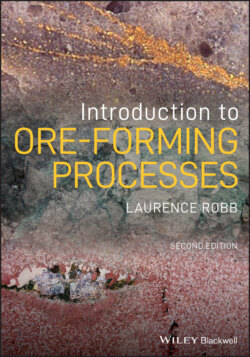Читать книгу Introduction to Ore-Forming Processes - Laurence Robb - Страница 10
Preface to the 1st Edition
ОглавлениеThere are many excellent texts, available at both introductory and advanced levels, that describe the Earth's mineral deposits. Several describe the deposits themselves and others do so in combination with explanations that provide an understanding of how such mineral occurrences form. Few are dedicated entirely to the multitude of processes that give rise to the ore deposits of the world. The main purpose of this book is to provide a better understanding of the processes, as well as the nature and origin, of mineral occurrences and how they fit into the Earth system. It is intended for use at a senior undergraduate level (third and fourth year levels), or graduate level (North America), and assumes a basic knowledge in a wide range of core earth science disciplines, as well as in chemistry and physics. Although meant to be introductory, it is reasonably comprehensive in its treatment of topics, and it is hoped that practicing geologists in the minerals and related industries will also find the book useful as a summary and update of ore‐forming processes. To this end the text is punctuated by a number of boxed case studies in which actual ore deposits, selected as classic examples from around the world, are briefly described to give context and relevance to processes being discussed in the main text.
Metallogeny, or the study of the genesis of ore deposits in relation to the global tectonic paradigm, is a topic that traditionally has been, and should remain, a core component of the university earth science curriculum. It is also the discipline that underpins the training of professional earth scientists working in the minerals and related industries of the world. A tendency in the past has been to treat economic geology as a vocational topic and to provide instruction only to those individuals who wished to specialize in the discipline or to follow a career in the minerals industries. In more recent years, changes in earth science curricula have resulted in a trend, at least in a good many parts of the world, in which economic geology has been sidelined. A more holistic, process‐orientated approach (earth systems science) has led to a wider appreciation of the Earth as a complex interrelated system. Another aim of this book, therefore, is to emphasize the range of processes responsible for the formation of the enormously diverse ore deposit types found on Earth and to integrate these into a description of Earth evolution and global tectonics. In so doing it is hoped that metallogenic studies will increasingly be reintegrated into the university earth science curricula. Teaching the processes involved in the formation of the world's diminishing resource inventory is necessary, not only because of its practical relevance to the real world, but also because such processes form an integral and informative part of the Earth system.
This book was written mainly while on a protracted sabbatical in the Department of Earth Sciences at the University of Oxford. I am very grateful to John Woodhouse and the departmental staff who accommodated me and helped to provide the combination of academic rigor and quietude that made writing this book such a pleasure. In particular Jenny Colls, Earth Science Librarian, was a tower of support in locating reference material. The “tea club” at the Banbury Road annexe provided both stimulation and the requisite libations to break the monotony. The staff at Blackwell managed to combine being really nice people with a truly professional attitude, and Ian Francis, Delia Sandford, Rosie Hayden, and Cee Pike were all a pleasure to work with. Dave Coles drafted all the diagrams and I am extremely grateful for his forebearance in dealing amiably with a list of figures that seemingly did not end. Several people took time to read through the manuscript for me and in so doing greatly improved both the style and content. They include John Taylor (copyediting), Judith Kinnaird and Dave Waters (Introduction), Grant Cawthorn (Chapter 1), Philip Candela (Chapter 2), Franco Pirajno (Chapter 3), Michael Meyer (Chapter 4), John Parnell and Harold Reading (Chapter 5), and Mark Barley, Kevin Burke, and John Dewey (Chapter 6). The deficiencies that remain, though, are entirely my own. A particularly debt of gratitude is owed to David Rickard, who undertook the onerous task of reviewing the entire manuscript; his lucid comments helped to eliminate a number of flaws and omissions. Financial support for this project came from BHP Billiton in London and the Geological Society of South Africa Trust. My colleagues at Wits were extremely supportive during my long absences, and I am very grateful to Spike McCarthy, Paul Dirks, Carl Anhauesser, Johan Kruger, and Judith Kinnaird for their input in so many ways. Finally, my family, Vicki, Nicole, and Brendan, were subjected to a lifestyle that involved making personal sacrifices for the fruition of this project – there is no way of saying thank you and it is to them that I dedicate this book.
Laurence Robb Johannesburg
